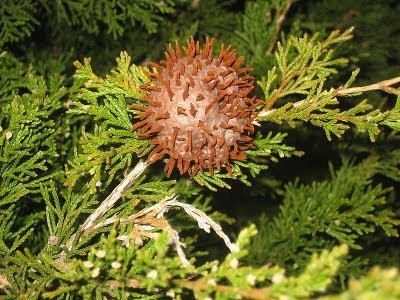Rust: The Conclusion

A moody morning after rain. The rusts had poured forth their tentacles again, but after a few hours the tentacles had withered to brown scraps. My oldest son and I decided to retrieve one of them for study. He held a slender branch taut while I cut. The shears met in the wet wood with a squeak and a snap; the branch sprang upward, leaving its severed extremity in my son's hands. He plucked the rust off it avidly.
We watered it in a jar and it revived. Overnight, new tendrils of orange slime pushed their way out through the colandered sphere. It did not need rain, then; any drenching would do.
The next stage of our inquiry was a white plastic cup. We had learned that the rust spreads orange spores while it's active. Looking over its gelatinous tentacles, I had no doubt our specimen was alive, but we made the experiment anyway. Into the little white cup it went with a fresh supply of water. In the morning, the water showed orange against the cup—its spores coloring the water like a weak dose of Tang.
For a few days, my sons were always bringing in bigger, juicier specimens of the rust, poking them with sticks, marveling at them. Then their interest dwindled, and I'd find week-old jars of the things on shelves and window sills, the tentacles half dissolved in the water, retaining only their color.
*
I always suspected we were cousins. The fungi don't move the way we do, but some of them, the most visible ones, grow so fast it seems a sign of animal life: the mushroom big as a human fist found on your lawn the day after a rain, for example. I have a vivid childhood memory: something smooth and white nesting in the grass, the size and shape of a chicken egg, hardboiled and peeled. It was not an egg, however: my dog evinced no interest in it. Something about it made me reticent to touch it. It had no smell, but something about it reminded me of dog feces, or perhaps merely the Platonic form of disgust. The weird notion that it was an eyeball crossed my mind, and I went so far as to turn it over with a twig, looking for an iris. It was this operation that revealed its true nature to me, for it tore open under the stick and revealed, first, the stringy origami I associated with the insides of some mushrooms. The other thing this tearing revealed was the smell, which had hitherto been undetectable, the smell of rotten flesh.
Or maybe their overnight appearances simply seem like a sinister kind of magic. Toadstools, elves.
*
It is not only the plants that live in symbiosis with fungi. We animals do it, too. We do not like to think of it, because we have for so long conceived of microbes as unclean things, as invaders. But of course we have always been symbionts, dependent on the microbes in our guts to digest our food. We have colonies of fungus inside us as well. A so-called yeast infection is really an imbalance. It is not a problem that the yeasts are in the human body—they always are. It's a problem that their numbers have, because of some teetering of the pH level, exceeded their usual bounds. It is a natural thing to share our bodies with them, and with all manner of other organisms. As a tree is not simply a tree, we are not simply what we think we are.
Which is not to exonerate them all. Plenty of fungi are pure parasites, and these have invaded almost every kind of life. There are specialized fungal parasites of single-celled diatoms and even of other fungi. And some of these cause serious harm. The rust on my cedar tree was bad for it; it must have been even worse for the apple trees in the neighborhood, for the leaves of the apple are slowly pierced through by the rust, until spore-shooting orange masts sprout from their undersides. The fruit of the apple, too, may be ruined, its hide marred by soft brown patches.
So, too, with the human form. There are fungi to make the feet and the testicles itch, fungi to discolor and deform the fingernails. And there are neighborly fungi content to live within us unobserved, but which will blossom, in the case of a ruined immune system, into devouring sores, inside and out. It is a common enough way for people with AIDS to die.
*
Two years have passed since the last time our cedar was dazzling in its orange jewelry. The next year we waited in vain for another blooming of that odd fungal life. We had trimmed them off where we could reach, hoping to save the tree, but it wasn't our earthbound efforts that drove them away. We could still see dozens of them higher up, dry and drab, refusing to bloom.
Our tree grows shaggier year by year, more patched with vanilla and auburn. Within the greenery that remains I can reach dozens of lifeless branches. A good yank is sure to be rewarded with the crack of dead wood, dry enough to burn. The whole tree is ugly now, truth to tell. It reminds me of nothing so much as the shaggy head of a neglected old man.
Not that I neglect it. I prune; I am doing what I can to save its life. But it is dying, I'm sure of it. When we walk beneath it, mosquitoes and blackflies come for us by the swarm.
Next: An Intoxicating Fungus.
This story originally appeared in Discover.
Published on August 31, 2011 09:47
No comments have been added yet.



